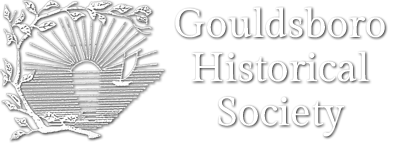Gouldsboro, Maine was first settled in the area now called West Gouldsboro and this became Gouldsboro’s first village. Land, in what was then the County of Lincoln, was given to Colonel Nathan Jones, Francis Shaw and Robert Gould in 1764 by the General Court of said Commonwealth of Massachusetts. Named after Robert Gould, the area was then called Gouldsboro Plantation.

After the Revolutionary War, attempts were made to get the remote eastern areas of what was then Massachusetts settled (now part of Maine). Massachusetts needed more money, and the remote eastern region (Maine) was known for its abundance of natural resources. To help in this matter, Massachusetts initiated a lottery in 1786 to encourage people and enterprises to settle these eastern sections, then referred to as the Kennebec tract (a large part of today’s Somerset County) and the Penobscot tract (today’s Hancock and Washington Counties). Each tract comprised approximately 1 million acres.
On February 16, 1789, Gouldsboro was incorporated. The county name was changed to Hancock on June 25 of the same year. Of note is that the Gouldsboro census of 1790 shows Thomas Frazer as owning and operating a salt works company that sold salt to passing ships at what is now called Frazer Point in his honor. Frazer was the first non-Indian settler to that area and was also an African-American.
After the land lottery attempt failed to meet expectations, Massachusetts tried to sell whole townships in the region to some of its select wealthy citizens but this also failed. It was not until 1791 that land speculation began to materialize when Henry Knox and William Duer purchased both tracts at about 10 cents per acre. Their plan was to tap into the particular needs of French Noblemen who risked losing much of their wealth depending on the outcome of the French Revolution. Unfortunately, because the highly-leveraged venture went bankrupt and because their main intended buyer never arrived, this attempt also failed.

In approximately 1793, a wealthy Philadelphia citizen named William Bingham rescued the track’s development when he negotiated the purchase of the claims on most of the acreage in the tracks of land and began attempts at attracting European buyers. To protect his investment, in 1795 he decided to hire the well-respected General David Cobb of Massachusetts to move to the land and become his on-site agent. General Cobb had been an aide to General George Washington, a Speaker of the House, and a doctor among other accomplishments.
General Cobb developed the belief that the key to the successful development of the region was in its soil and promoting it to potential settlers and investors as a place that was exceptional for agriculture. In the meantime, Mr. Bingham continued to purchase more coastal property in what is now called Gouldsboro, Trenton, Ellsworth, and Mount Desert.
John Black, an Englishman, became General Cobb’s clerk in 1799. His talents soon allowed him to rise through the ranks and in 1802, Mr. Black married Mary Cobb, the General’s daughter. When a sub-agent for Ellsworth died in 1805, Colonel John Black was appointed to take over the position.

Colonel John Black had a difference of perspective regarding the value of the surrounding land from General Cobb. Colonel Black believed that its true potential was not in agriculture, but rather in its lumber trade. It was likely this difference and Black’s exceptional management abilities that allowed him to eventually eclipse General Cobb and become the general agent for Bingham’s properties in what became Maine.
Gouldsboro, Maine now covers the majority of the area from western sections of Frenchman Bay that includes Long Porcupine Island, Sheep Porcupine Island, Bald Porcupine Island, the western shore of the peninsula across to the eastern shore to the central section of Gouldsboro Bay. Parcels of land that were once part of Gouldsboro were annexed and became incorporated as Winter Harbor in 1895.
The United States Census Bureau says Gouldsboro, Maine covers a total area (land and water) of 100.8 square miles (261 sq. km). Of this area, 45.7% or 46.1 sq. miles (119.4 sq. km) is land and 54.3% or 54.7 sq. miles (141.6 sq.km) is water.
Courtesy of AcadiaMagic


